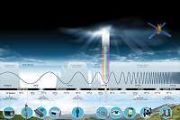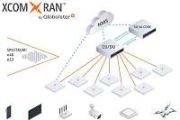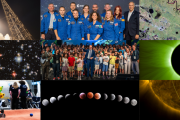
Copernical Team
NASA Exploration has LEGS
 NASA plans to implement three new ground stations that will provide near-continuous communications support to missions up to two million kilometers from Earth through NASA's Near Space Network. These Lunar Exploration Ground Sites (LEGS) will be critical to the success of NASA's Artemis program, providing needed and enhanced direct-to-Earth communications capabilities to lunar missions.
"T
NASA plans to implement three new ground stations that will provide near-continuous communications support to missions up to two million kilometers from Earth through NASA's Near Space Network. These Lunar Exploration Ground Sites (LEGS) will be critical to the success of NASA's Artemis program, providing needed and enhanced direct-to-Earth communications capabilities to lunar missions.
"T Dragonfly mission to Titan announces big science goals
 Among our solar system's many moons, Saturn's Titan stands out - it's the only moon with a substantial atmosphere and liquid on the surface. It even has a weather system like Earth's, though it rains methane instead of water. Might it also host some kind of life?
NASA's Dragonfly mission, which will send a rotorcraft relocatable lander to Titan's surface in the mid-2030s, will be the first
Among our solar system's many moons, Saturn's Titan stands out - it's the only moon with a substantial atmosphere and liquid on the surface. It even has a weather system like Earth's, though it rains methane instead of water. Might it also host some kind of life?
NASA's Dragonfly mission, which will send a rotorcraft relocatable lander to Titan's surface in the mid-2030s, will be the first New evidence of recent Venusian volcanism
 New data analysis techniques allow evidence of recent volcanism to be found in old Magellan spacecraft data. It is unclear if this activity is occurring today, or if it occurred within tens of million years, but geologically speaking, either case is recent. This adds to the growing body of evidence that volcanoes on Venus didn't go extinct as long ago as many had thought. This work was conducted
New data analysis techniques allow evidence of recent volcanism to be found in old Magellan spacecraft data. It is unclear if this activity is occurring today, or if it occurred within tens of million years, but geologically speaking, either case is recent. This adds to the growing body of evidence that volcanoes on Venus didn't go extinct as long ago as many had thought. This work was conducted Aviation Week awards NASA's Ingenuity Mars Helicopter with laureate
 The "little helicopter that could" has garnered attention, fans, and numerous accolades, with the latest coming from Aviation Week Network in the form of a 2021 Laureate Award. The Laureate Awards honor "extraordinary achievements in aerospace."
When the 4-pound (1.8 kilogram) rotorcraft hovered on Mars for 39.1 seconds on April 19, 2021, it was the first instance of powered, controlled fl
The "little helicopter that could" has garnered attention, fans, and numerous accolades, with the latest coming from Aviation Week Network in the form of a 2021 Laureate Award. The Laureate Awards honor "extraordinary achievements in aerospace."
When the 4-pound (1.8 kilogram) rotorcraft hovered on Mars for 39.1 seconds on April 19, 2021, it was the first instance of powered, controlled fl Next Vega mission to orbit Pleiades Neo 4 EO bird and 4 small science sats
 On Monday, August 16, 2021 at 10:47 pm local time (01:47 am (UTC) on Tuesday, August 17), Arianespace's second Vega mission of the year will lift off from Europe's Spaceport in French Guiana, with the optical observation satellite Pleiades Neo 4 and four auxiliary passengers.
After liftoff from Europe's Spaceport, the Vega launcher will fly for a little over six minutes, powered by the fir
On Monday, August 16, 2021 at 10:47 pm local time (01:47 am (UTC) on Tuesday, August 17), Arianespace's second Vega mission of the year will lift off from Europe's Spaceport in French Guiana, with the optical observation satellite Pleiades Neo 4 and four auxiliary passengers.
After liftoff from Europe's Spaceport, the Vega launcher will fly for a little over six minutes, powered by the fir Spacesuit delays threaten moon landing plans, NASA watchdog says
 Delays and cost overruns developing new spacesuits could derail NASA's planned return to the moon by 2024, the space agency's official watchdog said in a report Tuesday.
Cost projections for the spacesuit development are approaching $1 billion, according to the report from NASA's Office of the Inspector General. It attributed delays to the coronavirus pandemic, technical challenges and
Delays and cost overruns developing new spacesuits could derail NASA's planned return to the moon by 2024, the space agency's official watchdog said in a report Tuesday.
Cost projections for the spacesuit development are approaching $1 billion, according to the report from NASA's Office of the Inspector General. It attributed delays to the coronavirus pandemic, technical challenges and Blobs in space: Slime mold to blast off for ISS experiment

Astronauts aboard the International Space Station are set to welcome a most unusual guest, as "the Blob" blasts off into orbit on Tuesday.
An alien on its own planet, the Blob is an unclassifiable organism—neither fish nor fowl. Nor is it plant, animal or fungus.
As such, Physarum polycephalum—a type of slime mold—has long fascinated scientists and will now be part of a unique experiment carried out simultaneously by astronauts hundreds of kilometers above the Earth and by hundreds of thousands of French school students.
The slime mold first appeared on Earth around 500 million years ago, and defies conventional biology because it is made up of one cell with multiple nuclei.
While most organisms grow and reproduce through the division and multiplication of cells, Physarum polycephalum does not.
Space Olympics (full video)
 Video:
00:09:41
Video:
00:09:41
The International Space Station Expedition 65 crew recorded themselves on a day off after a long week of work having some weightless fun. From Earth orbit, 400 km above our planet, the crew present the very first Space Olympics.
ESA astronaut Thomas Pesquet shared this video on social media with the caption:
“The first ever Space Olympics ! A Saturday afternoon on the International Space Station. Four disciplines. Rules that evolved as we played. Seven athletes. Four nations. Two teams. Crew cohesion and morale boosted like never before. The first Space Olympics saw Team Crew Dragon and Team Soyuz
BepiColombo skims past Venus
 Image:
BepiColombo skims past Venus
Image:
BepiColombo skims past Venus Light pollution and spotting Perseid meteors

Many Perseid-related news stories and social media posts state that the maximum rate is about 100 meteors per hour, which is a lot. So, folks get excited and go out on the peak night, braving mosquitos and other nightly hazards. But they are often disappointed; we routinely hear, "I went out and only saw a few meteors. Not even 20, much less 100!" And they would be right. The problem is that the 100 per hour is a theoretical number used by meteor scientists and does not convey what people are actually going to see.
In the 1980s, meteor researchers were searching for a way to compare the meteor shower rates observed by various individuals and groups across the globe. People were reporting the rates, but the differences in sky conditions, radiant altitude and observer eyesight made getting a comprehensive view of shower activity difficult.
So, the meteor researchers put their heads together and came up with the concept of a ZHR, or Zenithal Hourly Rate. The ZHR is what you get after you correct the observed rates for the sky conditions, the altitude of the radiant above the horizon and observer biases.






























